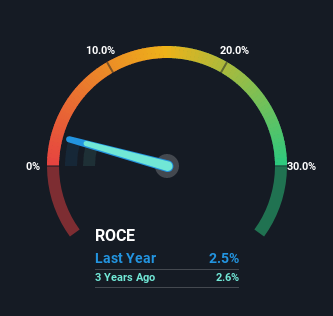- United States
- /
- Electric Utilities
- /
- NYSE:HE
Here's What To Make Of Hawaiian Electric Industries' (NYSE:HE) Decelerating Rates Of Return

Finding a business that has the potential to grow substantially is not easy, but it is possible if we look at a few key financial metrics. Firstly, we'd want to identify a growing return on capital employed (ROCE) and then alongside that, an ever-increasing base of capital employed. If you see this, it typically means it's a company with a great business model and plenty of profitable reinvestment opportunities. However, after briefly looking over the numbers, we don't think Hawaiian Electric Industries (NYSE:HE) has the makings of a multi-bagger going forward, but let's have a look at why that may be.
Understanding Return On Capital Employed (ROCE)
For those who don't know, ROCE is a measure of a company's yearly pre-tax profit (its return), relative to the capital employed in the business. To calculate this metric for Hawaiian Electric Industries, this is the formula:
Return on Capital Employed = Earnings Before Interest and Tax (EBIT) ÷ (Total Assets - Current Liabilities)
0.025 = US$392m ÷ (US$16b - US$483m) (Based on the trailing twelve months to March 2022).
Therefore, Hawaiian Electric Industries has an ROCE of 2.5%. In absolute terms, that's a low return and it also under-performs the Electric Utilities industry average of 4.8%.
Check out our latest analysis for Hawaiian Electric Industries

In the above chart we have measured Hawaiian Electric Industries' prior ROCE against its prior performance, but the future is arguably more important. If you'd like to see what analysts are forecasting going forward, you should check out our free report for Hawaiian Electric Industries.
What Does the ROCE Trend For Hawaiian Electric Industries Tell Us?
In terms of Hawaiian Electric Industries' historical ROCE trend, it doesn't exactly demand attention. The company has employed 25% more capital in the last five years, and the returns on that capital have remained stable at 2.5%. Given the company has increased the amount of capital employed, it appears the investments that have been made simply don't provide a high return on capital.
The Bottom Line On Hawaiian Electric Industries' ROCE
In summary, Hawaiian Electric Industries has simply been reinvesting capital and generating the same low rate of return as before. Although the market must be expecting these trends to improve because the stock has gained 49% over the last five years. But if the trajectory of these underlying trends continue, we think the likelihood of it being a multi-bagger from here isn't high.
Since virtually every company faces some risks, it's worth knowing what they are, and we've spotted 3 warning signs for Hawaiian Electric Industries (of which 1 is significant!) that you should know about.
For those who like to invest in solid companies, check out this free list of companies with solid balance sheets and high returns on equity.
Valuation is complex, but we're here to simplify it.
Discover if Hawaiian Electric Industries might be undervalued or overvalued with our detailed analysis, featuring fair value estimates, potential risks, dividends, insider trades, and its financial condition.
Access Free AnalysisHave feedback on this article? Concerned about the content? Get in touch with us directly. Alternatively, email editorial-team (at) simplywallst.com.
This article by Simply Wall St is general in nature. We provide commentary based on historical data and analyst forecasts only using an unbiased methodology and our articles are not intended to be financial advice. It does not constitute a recommendation to buy or sell any stock, and does not take account of your objectives, or your financial situation. We aim to bring you long-term focused analysis driven by fundamental data. Note that our analysis may not factor in the latest price-sensitive company announcements or qualitative material. Simply Wall St has no position in any stocks mentioned.
About NYSE:HE
Hawaiian Electric Industries
Engages in the electric utility businesses in the United States.
Fair value with moderate growth potential.

